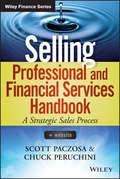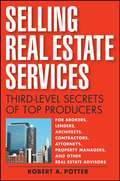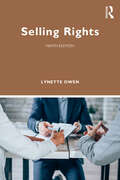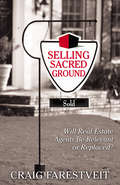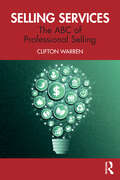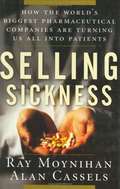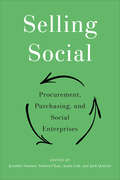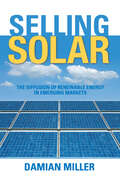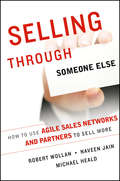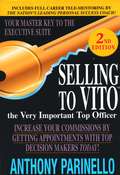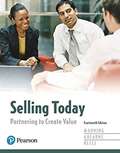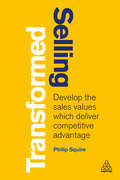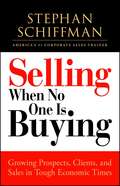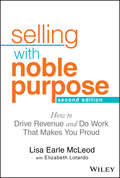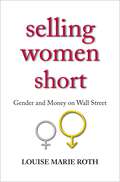- Table View
- List View
Selling Professional and Financial Services Handbook + Website
by Scott Paczosa Chuck PeruchiniAn effective strategic framework for successful face-to-face selling for financial services industry professionalsTimes are very tough for people who sell professional services and Selling Professional and Financial Services Handbook offers a new solution proven in practice. The book describes methods the authors have used and taught since the 1990s, most recently at a major consulting firm, where they led a Global Business Development team to revenue gains of 500% over six years -- in a period that included the recession of 2008-10.The solution is not any new twist on face-to-face selling techniques or the art of persuasion. It's a strategic approach built around a simple fact: the markets are tight but far from static. Even with lean budgets, client companies must respond to urgent changes and emerging threats in their industries. Thus they will buy services from the sellers who can help them detect, understand, and cope with what's coming their way.This handbook outlines a systematic way of becoming such a valued resource. Readers learn to scan the horizon for early signs of "rock-ripple events." Major changes in the business world often spring from new developments that are little noted or heeded, at first, by the client companies soon to be affected by them. But like a rock dropped in a pond, these events set off ripples that sweep through entire industry sectors, creating must-have service needs.The book is written for everyone who sells, or is responsible for selling, professional services. This includes but is not limited to: law firms, consulting firms, finance industry, public relations, engineering, and architectural services.Readers who can benefit from the dynamic approach hold a variety of positions. They include:Attorneys, consultants and other practitioners who must sell their services as well as execute.CEOs, equity partners, practice-area leaders, functional and divisional leadersPrivate Equity or Venture Capital executivesSales or business-development professionals, from entry level to senior levelSales and marketing managersBut the book is for sellers in every category who need a new and better approach to selling. Many, even the most skilled, simply have not adjusted to the new normal of today's economy. They persist with old strategies that cannot be as productive as they once were, such as pursuing one-off opportunities (which are too few and too hard to win in lean times) or old-style "relationship selling" (which gains little if any traction). Selling Professional and Financial Services Handbook gives all such readers a new strategic framework within which to apply their face-to-face selling skills. It is an approach that puts them in position to win -- so they can sell from ahead of the game, instead of struggling to keep up with it.
Selling Real Estate Services
by Robert A PotterPraise for Selling Real Estate Services"Selling Real Estate Services shows you how to stop being a vendor and start being a partner. Bob Potter's Third-Level concept will help you win more, have more fun, and build greater client loyalty. It's a playbook for success."--Roger T. Staubach, Executive Chairman for the Americas, Jones Lang LaSalle, and founder of The Staubach Company"It's not just about selling; it's about winning. Just in time for one of the most competitive markets in a generation. Be prepared to win."--Robert A. Ortiz, Executive Managing Director - U.S. Operations, Cushman & Wakefield Inc."Bob Potter's Third-Level Selling offers a progressive, advanced approach to building trust, demonstrating value, and winning. Whether you are new to real estate or a seasoned veteran, it will take your career to the next level."--Craig Robbins, Chief Knowledge Officer, Colliers International"Business development never stops for successful real estate companies. Bob Potter gets it, and his simple strategies and techniques can be implemented immediately across a sales-oriented organization. This book is a gem."--Tom Donnelly, President and COO, ValleyCrest Landscape Development"Rarely do books capture the essence of success in our industry. Third-Level Selling helps one understand how you build long-term committed relationships with clients. This book is a road map to becoming a top producer; I only hope that my competition doesn't read it!"--Dan Winey, Managing Principal, Gensler
Selling Rights
by Lynette OwenNow in its ninth edition, Selling Rights has firmly established itself as the leading guide to all aspects of rights sales and co-publications throughout the world.Covering the full range of potential rights, from English-language territorial rights through to serial rights, permissions, rights for the reading-impaired, translation rights, dramatization and documentary rights, electronic and multimedia rights, this book constitutes a comprehensive introduction and companion to the topic. Besides individual types of rights, topics covered also include book fairs, Open Access, the ongoing impact of new electronic hardware, and the rights implications of acquisitions, mergers, and disposals.This fully updated edition includes:• New IP legislation and proposed legislation in the UK and the USA, including changes regarding TDM and the post-Brexit implications of EU directives and exhaustion of rights.• The implications of artificial intelligence (AI) for author contracts and licensing contracts.• The impact of the pandemic and its aftermath on the promotion and sale of rights.• Coverage of censorship in countries around the world, especially in relation to LGBTQI+ content, as well as political situations which have impacted on rights trading.• The impact of streaming services on opportunities for licensing television and film rights.• Major revisions to the chapters on audio and video recording rights, the internet and publishing, and electronic publishing and digital licensing.Selling Rights is an essential reference tool and an accessible and illuminating guide to current and future issues for rights professionals and students of publishing.
Selling Sacred Ground: Will Real Estate Agents Be Relevant or Replaces?
by Craig FarestveitSelling Sacred Ground takes an in-depth look at the real estate sales process and whether or not the real estate agent will be relevant or worthy of replacement in the marketplace.With over 5 million homes selling in the US every year, our growing DIY culture is asking if the traditional real estate agent is worth the commissions paid in all of those transactions. After all, traditional &“experts&” such as travel agents, stock brokers, and even doctors have been forced to adjust their roles with sites such as Expedia, Charles Schwab, and WebMD available to the public.Whereas most real estate resources are focused on how to get more clients and even more money from those clients, long-term veteran Craig Farestveit addresses how to actually do the job well for clients. A sobering how-to for those considering a career in real estate, Selling Sacred Ground looks at what a good real estate agent actually does in the sale of the home, helping those buying or selling decide if an agent is worth the cost and guiding experienced real estate agents to growth in a changing marketplace.
Selling Services: The ABC of Professional Selling
by Clifton WarrenMore than ever, our economy relies on the service industries – but selling services is far different from selling tangible products. This book demystifies the selling of intangibles and teaches the required skills to grow any professional service business. Leveraging his 30 years’ experience, leading sales expert Clifton Warren offers 26 lessons to help readers navigate the selling of complex and intangible solutions. Each chapter covers an important concept from A (Accountability) to Z (Zigzagging) in a concise and readable format, including a "to-do" action list that makes the book both a workbook and a study guide. By successfully applying the steps discussed in each chapter, professionals will substantially improve their performance and results, and anyone looking to drill down into specific topics will find additional resources to explore. B2B sales professionals in banking, insurance, finance, and other services, and small business owners such as lawyers, architects, and engineers, as well as professionals transitioning into sales roles, will appreciate the thorough and easy-to-follow guidance that this book provides.
Selling Sexy: Victoria’s Secret and the Unraveling of an American Icon
by Lauren Sherman Chantal FernandezThe story of how Victoria’s Secret skyrocketed from a tiny chain of boutiques to a retail phenomenon with more than $8 billion in annual sales at its peak—all while defining an impossible beauty standard for generations of American women—before the brand’s tight grip on the industry finally slippedVictoria’s Secret is one of the most influential and polarizing brands to ever infiltrate the psyche of the American consumer. Almost right at its start in the late 1970s, the company developed a cult following for its glamorous catalogs. Back then, shoppers had few alternatives to the stodgy department stores that sold most of the nation’s intimate apparel. By 1982, the founders of Victoria’s Secret avoided bankruptcy by selling to Les Wexner, the fast-fashion pioneer behind the Limited, whose empire of mall brands would go on to dominate American retail for forty years.Wexner turned Victoria’s Secret into a multibillion-dollar business, and the brand’s cultural influence soared thanks to its airbrushed advertisements and annual televised fashion show, which drew millions of viewers each year. Its supermodel spokeswomen, the sweet but sultry Angels, personified a new American beauty standard.But as our definition of beauty expanded, Victoria’s Secret failed to evolve and reached a crisis point. Meanwhile, Wexner became increasingly known for his complicated relationship with sex trafficker Jeffrey Epstein, his former financial adviser and confidant.Selling Sexy expertly draws from sources within Victoria’s Secret and across the industry to examine the unprecedented rise of one of the most innovative brands in retail history—a brand that today, under new ownership, is desperately trying to seduce shoppers again.
Selling Sickness: How the World's Biggest Pharmaceutical Companies Are Turning Us All Into Patients
by Ray Moynihan Alan CasselsThis book presents a valuable counterweight to the mind-numbing barrage of unproven diagnoses and just plain dysinformation that haunts the airwaves and even some medical journals.
Selling Social: Procurement, Purchasing, and Social Enterprises
by Jack Quarter Andrea Chan Jennifer Sumner Annie LukSince the 2010s, all levels of governments in Canada have gradually initiated social procurement as a policy tool to further their social values and political agendas. Social enterprises of various shapes and sizes across the country have served as partners in the execution of those agendas. Selling Social examines the experiences of these enterprises in social procurement and social purchasing. Selling Social presents the findings of a three-year Canadian research project detailing experiences of work integration social enterprises (WISEs) selling their goods and services to organizational purchasers, including governments, businesses, and non-profit organizations. Drawing on survey findings and interviews, the book explores a diverse group of social enterprises from across Canada, showcasing their successes and their challenges based on real-life examples to aid social enterprises that are considering this path. The book emphasizes the importance of including social and environmental considerations in procurement and purchasing decisions, particularly at larger scales and through public policy. In doing so, Selling Social extends the understanding of social enterprises beyond their social and economic outcomes and into the broader movement towards responsible procurement and purchasing.
Selling Solar: The Diffusion of Renewable Energy in Emerging Markets
by Damian MillerTo solve the climate crisis, the world must make a wholesale shift to renewable energy technologies. With surging growth in emerging markets, this transformation takes on even greater urgency. The challenges - and opportunities - are immense. Selling Solar considers how such a shift might happen. Focusing on the case of solar photovoltaics, it shows how, at the start of the 21st century, this promising technology began to diffuse rapidly in select emerging markets, after years of struggling to take off. What were the initial barriers to diffusion? How were they overcome? Who did it? And how can this success be replicated? Drawing on literature on innovation diffusion and entrepreneurship, the author answers these questions, showing how entrepreneurs affected profound technological change not just through the solar systems they sold, but through the example they set to both new market entrants and policymakers. In analysing how this happened, this book offers important lessons for the diffusion of a range of renewable energy technologies in emerging markets, and for the advancement of the sector as a whole. Selling Solar is essential reading for anyone who believes in a renewable energy future and wants it sooner rather than later.
Selling Sounds: The Commercial Revolution in American Music
by David SuismanFrom Tin Pan Alley to grand opera, player-pianos to phonograph records, David Suisman's Selling Sounds explores the rise of music as big business and the creation of a radically new musical culture. Around the turn of the twentieth century, music entrepreneurs laid the foundation for today's vast industry, with new products, technologies, and commercial strategies to incorporate music into the daily rhythm of modern life. Popular songs filled the air with a new kind of musical pleasure, phonographs brought opera into the parlor, and celebrity performers like Enrico Caruso captivated the imagination of consumers from coast to coast. Selling Sounds uncovers the origins of the culture industry in music and chronicles how music ignited an auditory explosion that penetrated all aspects of society. It maps the growth of the music business across the social landscape -- in homes, theaters, department stores, schools -- and analyzes the effect of this development on everything from copyright law to the sensory environment. While music came to resemble other consumer goods, its distinct properties as sound ensured that its commercial growth and social impact would remain unique. Today, the music that surrounds us -- from iPods to ring tones to Muzak -- accompanies us everywhere from airports to grocery stores. The roots of this modern culture lie in the business of popular song, player-pianos, and phonographs of a century ago. Provocative, original, and lucidly written, Selling Sounds reveals the commercial architecture of America's musical life.
Selling Sunshine: Surviving Teenage Motherhood, Thriving in Luxury Real Estate, and Finally Finding My Voice
by Mary BonnetThe fan-favorite star of Netflix’s hit reality series Selling Sunset recalls her life in and out of the spotlight, an inspiring and surprising chronicle of adversity, tragedy, trauma, and success. In the streaming reality series Selling Sunset, Mary Fitzgerald Bonnet is the charismatic, calm, and level-headed agent who effortlessly lands multi-million-dollar homes while sidestepping the drama of a cutthroat business in one of the wealthiest and most glamorous places in the world. Often thought of as the “big sister” of her co-stars for her compassionate advice and uplifting attitude, Mary is admired for her unwavering kindness. But behind her sunny personality is a remarkable story of resilience, forged by a life filled with profound challenges.In Selling Sunshine, Mary candidly reveals the most grueling and darkest moments of her personal journey. Becoming a mother at sixteen, she was forced to rely on her own resolve and tenacity, juggling multiple jobs while attending school and caring for her son. With vulnerability and grace, Mary reflects on how her crash-course in adulthood not only changed her, but prepared her for the trials to come, including two painful divorces and toxic relationships. Despite the pain, she kept moving forward even in the aftermath of terrifying trauma.Yet no matter how many obstacles she faced, Mary refused to let the darkness extinguish her light. It was that same strength and determination that eventually carried her to the top of her field and helped her cope with unexpected fame. Talking about her experience on Selling Sunset, she offers a rare glimpse at cast dynamics and the drama behind the scenes, and reveals the lessons she’s learned—from staying true to yourself to projecting positivity by supporting colleagues. Unfiltered and genuine, Mary’s story will inspire readers to overcome life’s obstacles, and discover the power of finding their own sunshine. Selling Sunshine includes a 16-page color photo insert.
Selling Sustainability Short?: The Private Governance of Labor and the Environment in the Coffee Sector (Organizations and the Natural Environment)
by Janina GrabsCan private standards bring about more sustainable production practices? This question is of interest to conscientious consumers, academics studying the effectiveness of private regulation, and corporate social responsibility practitioners alike. Grabs provides an answer by combining an impact evaluation of 1,900 farmers with rich qualitative evidence from the coffee sectors of Honduras, Colombia and Costa Rica. Identifying an institutional design dilemma that private sustainability standards encounter as they scale up, this book shows how this dilemma plays out in the coffee industry. It highlights how the erosion of price premiums and the adaptation to buyers' preferences have curtailed standards' effectiveness in promoting sustainable practices that create economic opportunity costs for farmers, such as agroforestry or agroecology. It also provides a voice for coffee producers and value chain members to explain why the current system is failing in its mission to provide environmental, social, and economic co-benefits, and what changes are necessary to do better.
Selling Textiles in the Long Eighteenth Century
by Jon Stobart Bruno BlondéTextiles are a key component of the industrial and consumer revolutions, yet we lack a coherent picture of how the marketing of textiles varied across the long 18th century and between different regions. This book provides important new insights into the ways in which changes in the supply of textiles related to shifting patterns of demand.
Selling Through Someone Else: How to Use Agile Sales Networks and Partners to Sell More
by Robert Wollan Michael Heald Naveen JainExperience the growth multiplier effect through transforming the distribution and sales network Selling Through Someone Else tackles new opportunities to drive company growth by taking a fresh look at the customer smart distribution and sales process.<P><P> The authors, from Accenture, one of the world's largest consulting companies, explain how companies can be smarter about what their customers truly want and maximize the return on investment from all available resources for growth opportunities by exploring creative distribution options, including leveraging partners, online outlets, iPads/tablets, your traditional sales force, and more. Selling <P>Through Someone Else demonstrates that traditional approaches are no longer effective and how, by capitalizing on converging forces, companies can transform their "sales" approaches to grow revenue, and enhance customer and brand loyalty. Explores how globalization, new competitors, and low-cost threats are reshaping the way sales is happening today, and how to prepare your company to be successful in this new dynamic and iterative selling model Shows how analytics, the shift to digital selling and mobile sales tools, and new approaches to sales operations can reshape the entire sales function Demonstrates how new ecosystems of partners are created, managed, and incented to drive greater sales and profitability Accenture has helped numerous clients collaborate across IT, Sales, and Marketing to dramatically grow distribution and adapt to the different "playing field" of today. Selling through Someone Else applies the trends and lessons learned from Fortune 500 and Global 500 companies to mid-sized enterprises and small-medium businesses owners.
Selling To Vito: The Very Important Top Officer
by Anthony ParinelloSelling to Vito contains all the tactics you need to get appointments with impossible-to-reach top decision-makers. They in fact are the Very Important Top Officers (VITOs), the people with the ultimate veto power who hold the key to bigger commission checks, every sales award you could possibly win, and VITO to VITO referrals that you can take to the bank!You'll quickly learn how to:Get into new accounts at the topKeep out of time-consuming log-jams-and into VITO's officePromote loyalty at the top with existing customers and capture add-on businessIncrease the size of every saleSelling To VITO offers innovative new ideas and street-smart tactics for reaching the very top person in any organization. It's based on the seminars that have helped thousands of sales professionals from top corporations like Canon, 3M, Hewlett-Packard, and MCI bust quotas and increase commissions. It can help you, too, by getting you to the right person so you can do what you do best: SELL!Anthony Parinello is without question the country's foremost expert on getting appointments with, and selling to, top decision makers. This book is the product of his twenty-three years of award-winning sales performance.
Selling Today: Partnering to Create Value
by Michael Ahearne Barry Reece Gerald ManningUtilize cutting-edge personal selling techniques to navigate the information revolution era, Selling Today: Partnering to Create Value helps you understand the value of developing personal selling skills by exposing you to a personal selling academic theory, role play scenarios, and real-world applications and ethical dilemmas. <p><p>With the largest number of “learn by doing” materials available in any personal selling text, the 14th Edition offers tools to strengthen your learning process. As the developed nations of the world transition from a production focus to a sales-and-service focus, this cutting-edge new edition prepares you to succeed as a member of a new generation of businesspeople.
Selling Tourism Services at a Distance
by Josep Maria Bech SerratNew rules on distance contracts provided for the Consumer Rights Directive of 25 October 2011 do not apply to package holidays or contracts falling within the scope of the Timeshare Directive. Moreover, contracts for passenger transport services and contracts for the provision of accommodation, car rental, catering or leisure services if the contract provides for a specific date or period of performance are not covered by some of these rules. Yet measures aimed at protecting the consumer when a contract is concluded via the phone, the Internet, by mail or other means of distance communication play a role in tourism. This book helps readers to navigate through uncertainties in travel contracts regarding information requirements, the right of withdrawal or providing alternative services. Findings reveal that consumer acquis is inadequately adapted to the features of the tourism industry when an optional instrument based on the Draft Common Frame of Reference might be used in the future.
Selling Transformed: Develop the Sales Values which Deliver Competitive Advantage
by Philip SquireFor years, sales people have struggled with cliched views of how they sell, while at the same time customers have become more sophisticated and discerning, stopping off at different or unconventional places in the sales funnel. The result is that the technique of sales people controlling the sales conversation and learning how to influence the customer no longer works. Selling Transformed introduces the new world of selling, and addresses the reasons why sales people are so poorly perceived. Selling Transformed provides fresh, tangible ideas on how to develop better sales practices. Focusing as much on the customers as on the sellers, it explains key theories of selling effectively and introduces four proven strategies that are based on the values customers look for in sales people: authenticity, client-centricity, proactive creativity and being tactfully audacious. Explaining what customers look for in sales people, and advising on how to develop and deliver these values, this is a new type of sales manual guaranteed to improve sales performance.
Selling Used Books Online: The Complete Guide to Bookselling at Amazon's Marketplace and Other Online Sites
by Stephen Windwalker Genevieve KazdinDiscusses how to get started selling used books online, with an emphasis on amazon.com. Also covers the basics of starting and running a business.
Selling When No One is Buying
by Stephan SchiffmanTimes are tough all over. Wall Street is shivering and consumer confidence is dropping like a rock. Yet it's possible for the enterprising salesperson to still gain prospects, sign new clients, and close the deal. All it takes is persistence, energy, some new thinking, and the advice of Stephan Schiffman, American's top corporate sales trainer. Schiffman shows you how to: Treat customers individually Make life easier for customers in bad times Show that bad times won't last forever Reorient their thinking now to prepare for the future Across America, the sales landscape is changing swiftly. But even in an economic downturn, salespeople can survive'and thrive! The key to success is to learn how to sell when no one is buying.
Selling When No One is Buying
by Stephan SchiffmanTimes are tough all over. Wall Street is shivering and consumer confidence is dropping like a rock. Yet it's possible for the enterprising salesperson to still gain prospects, sign new clients, and close the deal. All it takes is persistence, energy, some new thinking, and the advice of Stephan Schiffman, American's top corporate sales trainer. Schiffman shows you how to: Treat customers individually Make life easier for customers in bad times Show that bad times won't last forever Reorient their thinking now to prepare for the future Across America, the sales landscape is changing swiftly. But even in an economic downturn, salespeople can survive--and thrive! The key to success is to learn how to sell when no one is buying.
Selling When No One is Buying: Growing Prospects, Clients, and Sales in Tough Economic Times
by Stephan SchiffmanTimes are tough all over. Wall Street is shivering and consumer confidence is dropping like a rock. Yet it's possible for the enterprising salesperson to still gain prospects, sign new clients, and close the deal. All it takes is persistence, energy, some new thinking, and the advice of Stephan Schiffman, American's top corporate sales trainer. Schiffman shows you how to:Treat customers individuallyMake life easier for customers in bad timesShow that bad times won't last foreverReorient their thinking now to prepare for the future Across America, the sales landscape is changing swiftly. But even in an economic downturn, salespeople can survive-and thrive! The key to success is to learn how to sell when no one is buying.
Selling With Noble Purpose: How to Drive Revenue and Do Work That Makes You Proud
by Lisa Earle McLeodDon’t let anyone tell you that you have to choose between making money and making a difference. Selling With Noble Purpose: How to Drive Revenue and Do Work That Makes You Proud, 2nd Edition is an update of the acclaimed book that changed the game in sales. Using real-world data, compelling stories and psychological research, Selling With Noble Purpose explains why salespeople who genuinely understand how they can make a difference to customers outsell those who only focus on internal targets and quotas. Sales leadership experts McLeod and Lotardo reveal how a Noble Sales Purpose (NSP) can drive a team to outstanding sales numbers. Whether you’re an executive, manager or aspiring sales leader, you’ll discover how to find your own Noble Sales Purpose and create a sales force of True Believers. This new edition covers: How firms overcome ferocious competition and how you can do the same Why sales organizations with a clear NSP outperform traditional sales teams How to avoid the trap of behaving like a transactional salesperson Why well-intended leaders often unknowingly erode purpose and differentiation How to use your NSP to increase customer engagement Why an NSP gives you clarity during times of uncertainty In an era where organizations often believe that money is the primary way to motivate salespeople, Selling with Noble Purpose offers and exciting and sustainable alternative.
Selling Women Short: Gender and Money on Wall Street
by Louise Marie RothRocked by a flurry of high-profile sex discrimination lawsuits in the 1990s, Wall Street was supposed to have cleaned up its act. It hasn't. Selling Women Short is a powerful new indictment of how America's financial capital has swept enduring discriminatory practices under the rug. Wall Street is supposed to be a citadel of pure economics, paying for performance and evaluating performance objectively. People with similar qualifications and performance should receive similar pay, regardless of gender. They don't. Comparing the experiences of men and women who began their careers on Wall Street in the late 1990s, Louise Roth finds not only that women earn an average of 29 percent less but also that they are shunted into less lucrative career paths, are not promoted, and are denied the best clients. Selling Women Short reveals the subtle structural discrimination that occurs when the unconscious biases of managers, coworkers, and clients influence performance evaluations, work distribution, and pay. In their own words, Wall Street workers describe how factors such as the preference to associate with those of the same gender contribute to systematic inequality. Revealing how the very systems that Wall Street established ostensibly to combat discrimination promote inequality, Selling Women Short closes with Roth's frank advice on how to tackle the problem, from introducing more tangible performance criteria to curbing gender-stereotypical client entertaining activities. Above all, firms could stop pretending that market forces lead to fair and unbiased outcomes. They don't.
Selling Women's History: Packaging Feminism in Twentieth-Century American Popular Culture
by Emily WestkaemperOnly in recent decades has the American academic profession taken women's history seriously. But the very concept of women's history has a much longer past, one that's intimately entwined with the development of American advertising and consumer culture. Selling Women's History reveals how, from the 1900s to the 1970s, popular culture helped teach Americans about the accomplishments of their foremothers, promoting an awareness of women's wide-ranging capabilities. On one hand, Emily Westkaemper examines how this was a marketing ploy, as Madison Avenue co-opted women's history to sell everything from Betsy Ross Red lipstick to Virginia Slims cigarettes. But she also shows how pioneering adwomen and female historians used consumer culture to publicize histories that were ignored elsewhere. Their feminist work challenged sexist assumptions about women's subordinate roles. Assessing a dazzling array of media, including soap operas, advertisements, films, magazines, calendars, and greeting cards, Selling Women's History offers a new perspective on how early- and mid-twentieth-century women saw themselves. Rather than presuming a drought of female agency between the first and second waves of American feminism, it reveals the subtle messages about women's empowerment that flooded the marketplace.
